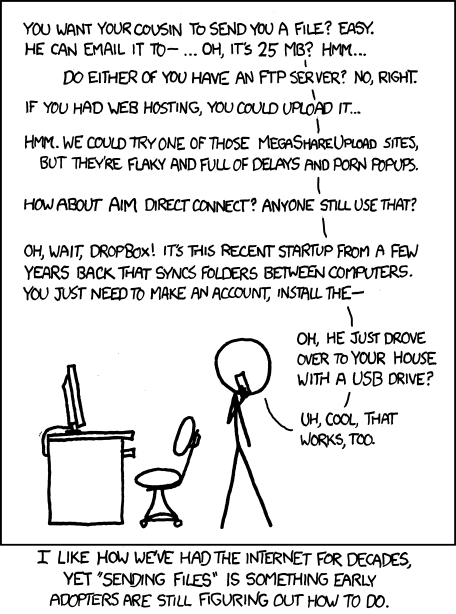So the term “Web 2.0″ struck me as vague and nondescript, so the first thing I did when starting the assignment was look up “Web 2.0″ on Wikipedia. And like everything else, I find that there are two sides to the whole notion of Web 2.0.
Among the disbelievers is Tim Berners-Lee, and seeing as how the man created the web, I am always more than willing to hear him out. Specifically, he called the term a “piece of jargon”, and admittedly, that’s pretty much what I thought when I saw our assignment (Great minds think a like?). I thought it was just buzzword with no inherent meaning that marketers could just slap on things to make them sound legit. Lee’s argument is that the web hasn’t changed–hasn’t moved from version 1.0 to 2.0–it was envisioned as a collaborative medium where people could meet, read, and write from the very beginning.
Aside from being racked with hilarity, this comic, helps to highlight that Lee really did envision a web like that:
‘
On the xkcd website, hovering over the comic reveals this additional text: “Every time you email a file to yourself so you can pull it up on a friends laptop Tim Berners-Lee sheds a single tear”.
My point in showing that, is that Tim Berners-Lee wouldn’t be shedding tears if he didn’t truly envision the web as a place for collaboration from the beginning, and it helps to highlight the gap in technology even now. Personally, I think the web really was founded on the ideals of Web 2.0, information sharing, interoperability, and collaboration. But the web is still in its infancy and technologies are rapidly changing, so these ideals are now becoming more and more fully realized. That doesn’t mean they weren’t there in the beginning. Consider the table from the Tim O’Reilly article (the man responsible for the term “Web 2.0″):
| Web 1.0 | Web 2.0 | |
|---|---|---|
| DoubleClick | –> | Google AdSense |
| Ofoto | –> | Flickr |
| Akamai | –> | BitTorrent |
| mp3.com | –> | Napster |
| Britannica Online | –> | Wikipedia |
| personal websites | –> | blogging |
| evite | –> | upcoming.org and EVDB |
| domain name speculation | –> | search engine optimization |
| page views | –> | cost per click |
| screen scraping | –> | web services |
| publishing | –> | participation |
| content management systems | –> | wikis |
| directories (taxonomy) | –> | tagging (“folksonomy”) |
| stickiness | –> | syndication |
The fact that those links can be generated indicates that these ideals were being actively worked on, but the technology had to catch up. So I don’t think we can divide it up into Web 1.0 and 2.0. The ideals of Web 2.0 have always been, what we see is change in technology that serves to more fully realize these ideals.


Add a comment